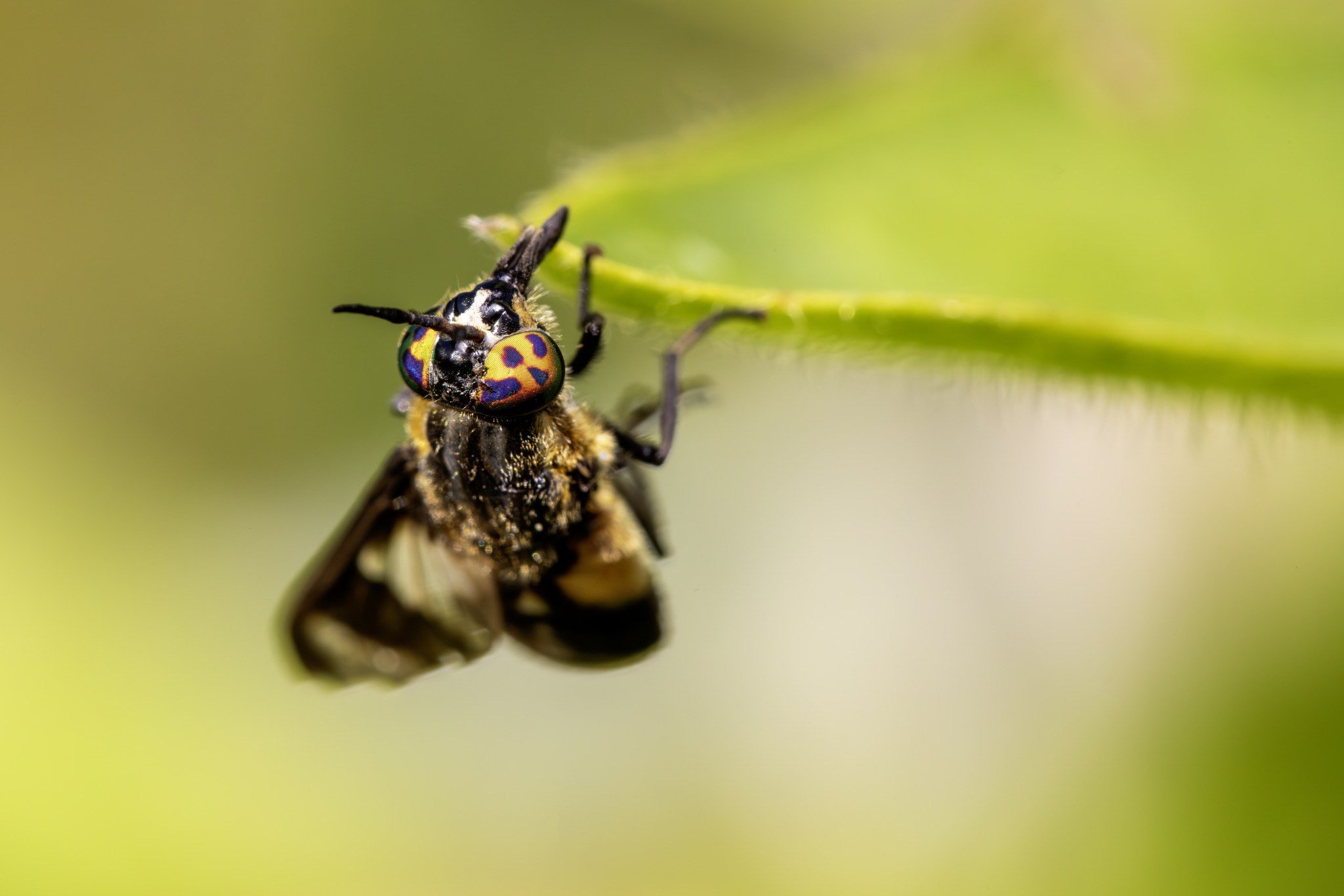Deep Overview: Splayed Deer Fly (Chrysops caecutiens)
The Splayed Deer Fly (Chrysops caecutiens) is a small but aggressive biting fly, commonly found in wetland areas, forests, and near bodies of water across Europe and parts of Asia. Like other deer flies, females are blood-feeders, targeting mammals (including humans), while males feed on nectar. Their distinctive banded wings, iridescent eyes, and painful bites make them a well-known nuisance during summer.
Taxonomy & Classification
- Kingdom: Animalia
- Phylum: Arthropoda
- Class: Insecta
- Order: Diptera (True Flies)
- Family: Tabanidae (Horse Flies & Deer Flies)
- Genus: Chrysops
- Species: Chrysops caecutiens
- Common Names:
- Splayed Deer Fly
- Banded Deer Fly
Physical Description
- Size: 7–12 mm in length
- Coloration & Markings:
- Compact body with a black-and-yellow pattern
- Distinctive, spotted wings with black bands (key identification feature)
- Large, iridescent compound eyes (often with a green or bronze shimmer)
- Females have serrated mouthparts, adapted for blood-feeding
- Key Features:
- Wings have two dark bands, forming a characteristic “H” shape
- Short, sturdy legs with bristles
- Males are smaller and lack biting mouthparts
Distribution & Habitat
- Geographic Range:
- Found across Europe, the UK, and parts of temperate Asia
- Widespread in Scandinavia, Russia, and Central Europe
- Preferred Habitat:
- Forests, marshlands, and wet meadows
- Near lakes, rivers, and boggy areas, where larvae develop
- Thrives in humid environments during warm months
Behavior & Adaptations
- Diurnal Activity:
- Most active on warm, sunny days, particularly in July and August
- Biting & Feeding Habits:
- Females require blood meals for egg development
- Targets mammals, including deer, livestock, and humans
- Bites are painful, as the fly cuts the skin rather than piercing it
- Flight Pattern:
- Agile and fast, often circling their target before landing
- Difficult to swat due to quick, erratic movements
- Mating & Territoriality:
- Males establish territories near flowering plants
- Courtship involves aerial chases and hovering displays
Diet & Feeding Habits
- Larvae:
- Carnivorous and scavenging, feeding on organic matter, small insects, and microorganisms in wet soil
- Adult Males:
- Strictly feed on nectar and plant juices
- Adult Females:
- Alternate between nectar-feeding and blood-feeding
- Prefer deer, cattle, horses, and humans
Reproduction & Life Cycle
- Breeding Season:
- Spring to summer, with peak activity in June–August
- Egg-Laying:
- Females lay clusters of eggs on vegetation near water
- Larval Stage:
- Larvae live in muddy, damp soil near wetlands
- Develop over several months to a year, depending on temperature
- Pupation:
- Occurs in moist soil, lasting a few weeks
- Adult Lifespan:
- Adults live for a few weeks to two months
Predators & Threats
- Natural Predators:
- Birds (swallows, flycatchers, swifts)
- Spiders and predatory insects (dragonflies, robber flies, wasps)
- Human-Related Threats:
- Habitat loss due to wetland drainage
- Insecticide use reduces populations but may also harm ecosystems
- Conservation Status:
- Stable population, not threatened
Ecological Importance
- Pollination:
- Males and females contribute to flower pollination while feeding on nectar
- Food Source for Other Species:
- Important prey for birds, spiders, and dragonflies
- Decomposers:
- Larvae help break down organic material in wetland ecosystems
Relationship with Humans
- Nuisance Pest:
- Bites can cause swelling, itching, and allergic reactions
- Active on hot summer days, often attacking exposed skin
- Disease Transmission:
- Can mechanically transmit pathogens, but not as significant as mosquitoes
- Control Measures:
- Wearing light-colored clothing reduces attraction
- Repellents (DEET, citronella) help deter bites
- Avoiding damp, wooded areas in peak season reduces risk of exposure
Similar Species & Identification
- Twin-lobed Deer Fly (Chrysops relictus)
- Similar but has lighter wing patterns and more transparent areas
- Common Horse Fly (Tabanus bromius)
- Larger, with clearer wings and a stockier body
Fun Facts
- Their wing patterns are unique, like fingerprints in humans
- They prefer humid conditions, disappearing when temperatures drop
- Their larvae are semi-aquatic, unlike most flies
- The name “Chrysops” means “golden eye”, referring to their shimmering eyes
- Their bite is one of the most painful among flies, as they slice the skin rather than pierce it
Conclusion
The Splayed Deer Fly is a small but aggressive biting insect, playing an essential role in pollination and wetland ecosystems. Despite being a seasonal nuisance to humans and livestock, it remains an important food source for birds and predatory insects. Understanding its behavior, habitat preferences, and ecological role helps in managing encounters while appreciating its place in nature.
Views: 527
Subscribe to the newsletter:
